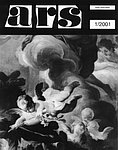
Časopis ARS 34 (2001) 1
Barbara BALÁŽOVÁ
Interiérová výzdoba bývalého kremnického farského kostola v období reformácie (archívny materiál)[Interior Decoration of the Former Parish Church in Kremnica in the Age of Reformation]
(Resumé)
In the Slovak Art of 17th Century in the Age of Reformation are not known many names of artists - architects, painters, sculptors. It depends from many reasons. One of them is the absence of an archival research. Especially the archival research sometime could offer to us the basic information because a lot of works of the 17th Century does not exist yet.
Now I would like to inform on the base of the archival research about new names of painters in the Slovak Art of 17th Century. They appeared in Kremnica - one of the famous Mining Towns in the Middle Slovakia - in connection with the interior decoration of the former Parish Church.
For the art of this period in Kremnica is very important a great fire in the 1560. Later the town's magistracy ordered a new main altar which was finished by an unknown painter in the 1592. But now we still have not exact information about the artist who had done it and we don't know also how this altar looked like.
In the 1618 the town's magistracy decided to order also the new interior decoration of the Parish Church and invited two brothers Samuel and Friderico Fabritii to do this. After some deliberations with the town major they came to Kremnica and the contract was signed definitely on the 18th August of the 1618. Follow this contract painters promised to divide the interior of the Parish Church into 43 illusive tables with columns and ledges and to paint them with oil colors. Except two brothers Fabritii is possible to find in the contract also the name of another painter Johann Wiechters who was painting together with Samuel and Friderico Fabritii. The other side - the town's magistracy promised to pay 365 gold coins and 50 kreutzers.
But we still don't know who were these two brothers Samuel and Friderico Fabritii. Probably they came from Vienna where they moved after finishing their work in the Parish Church in Kremnica.
Another information which could talk to us something about them is the note about the request of Samuel Fabritii in the 1619 when he asked for a certificate of birth the town's magistracy. Two of protestant priests in Kremnica confirmed that he belongs to the honest and German family.
The last note is more interesting. It is the note about the trial between Samuel Fabritii and the man called "Niderlander" who was one of the painter's group and he attacked Samuel directly in the Parish Church during their work. They had not just contended with words but finally they threw stones each other. But on the base of archival research we don't know yet what was the subject of their cause.
This new information about the Art of the 17th Century in the area of Mining Towns in the Middle Slovakia could help to other art historians in their study.